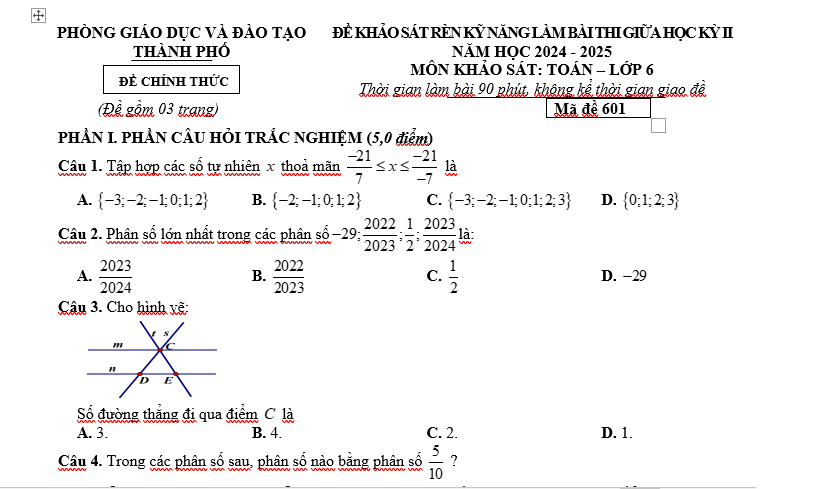What are the Top 03 2nd mid-semester question papers and answers for 6th-grade Mathematics in 2025? What are the objectives of the 6th-grade Mathematics Curriculum?
What are the Top 03 2nd mid-semester question papers and answers for 6th-grade Mathematics in 2025?
Students may refer to the following Top 03 2nd mid-semester question papers and answers for 6th-grade Mathematics in 2025:

Download - 2nd mid-semester question papers and answers for 6th-grade Mathematics
Download - 2nd mid-semester question papers and answers for 6th-grade Mathematics
Download - 2nd mid-semester question papers and answers for 6th-grade Mathematics
Note: The information is for reference only./.

What are the Top 03 2nd mid-semester question papers and answers for 6th-grade Mathematics in 2025? What are the objectives of the 6th-grade Mathematics Curriculum? (Image from Internet)
What are the objectives of the 6th-grade Mathematics curriculum in Vietnam?
Under Section III of the General education program in Mathematics as issued with Circular 32/2018/TT-BGDDT, the objectives for the 6th-grade Mathematics curriculum and the Mathematics curricula at the lower secondary level are outlined as follows:
(1) General objectives
The Mathematics curriculum helps students achieve the following main objectives:
- Form and develop mathematical capabilities, including core components: mathematical thinking and reasoning skills; mathematical modeling skills; problem-solving skills; mathematical communication skills; skills in using tools and methods for learning mathematics.
- Contribute to the formation and development of key qualities and general abilities at appropriate levels for the subject and education level as stipulated in the overall Curriculum.
- Acquire basic, essential Mathematics knowledge and skills; develop the ability to solve problems with interdisciplinary integration between Mathematics and other subjects like Physics, Chemistry, Biology, Geography, Computer Science, Technology, History, Arts, etc.; create opportunities for students to experience and apply mathematics in practice.
- Gain a relatively comprehensive understanding of the usefulness of mathematics in related professions to guide career orientation, as well as acquire sufficient minimal competencies to self-learn mathematics-related issues throughout life.
(2) Objectives at the lower secondary level
The Mathematics subject at the lower secondary level aims to help students achieve the following main objectives:
- Contribute to the formation and development of mathematical capabilities with the following requirements:
+ Formulate and answer questions during reasoning, problem-solving, and implement reasonable reasoning in problem-solving; prove not overly complicated mathematical propositions;
+ Use mathematical models (mathematical formulas, algebraic equations, representations, etc.) to describe situations arising in some not overly complex practical problems;
+ Use mathematical language combined with ordinary language to express mathematical content, as well as demonstrate evidence, reasoning methods, and results;
+ Present ideas and ways of using tools and methods to perform a learning task or to describe mathematical reasoning and proofs.
- Acquire fundamental Mathematics knowledge and skills regarding:
- Numbers and Algebra: Number system (from natural numbers to real numbers); calculation and use of calculation tools; algebraic language and symbols; transformation of algebraic expressions, equations, systems of equations, inequalities; use of function language to describe (model) some processes and phenomena in practice.
+ Geometry and Measurement:
++ The Geometry and Measurement content at this level includes Visual Geometry and Plane Geometry. Visual Geometry continues to provide language, symbols, and descriptions (at a visual level) of real-world objects (plane figures, solids); establish some common geometric models; calculate some geometric elements; develop spatial imagination; solve some simple practical problems associated with Geometry and Measurement.
++ Plane Geometry provides knowledge and skills (at a logical reasoning level) about geometric relationships and some common plane figures (point, line, ray, segment, angle, parallel lines, triangles, quadrilaterals, circles).
+ Statistics and Probability: Collect, classify, represent, analyze, and process statistical data; analyze statistical data through frequencies, relative frequencies; recognize some simple statistical rules in practice; use statistics to understand basic concepts of experimental probability of an event and the probability of an event; recognize the significance of probability in practice.
- Contribute to helping students have an initial understanding of professions related to Math; have career awareness based on abilities and interests, personal conditions and circumstances; orient towards educational pathways after middle school (continuing education, vocational training, or participating in labor life).
What are the requirements regarding the educational methods for 6th-grade students in Vietnam?
Under Clause 2, Article 7 of the Education Law 2019, the requirements regarding the educational content and methods are as follows:
Requirements on contents, methods of education
1. Contents of education must ensure the basic, comprehensive, practical, modern, systematic and up-to-date characteristics; with importance attached to ideological, ethical and civic consciousness education; preserving and developing the good traditions and the national cultural identity, absorbing the essence of the mankind culture; and suitable with the physical, intellectual and psycho-physiology development of various age groups and abilities of learners.
2. Methods of education must be scientific and bring into full play the activeness, consciousness, self-motivation and creative thinking of learners; foster self-study and cooperative abilities, practical ability, learning eagerness and the will to advance forward.
Thus, according to the above regulation, educational methods for 6th-grade students must be scientific and bring into full play the activeness, consciousness, self-motivation and creative thinking of learners; foster self-study and cooperative abilities, practical ability, learning eagerness and the will to advance forward.

